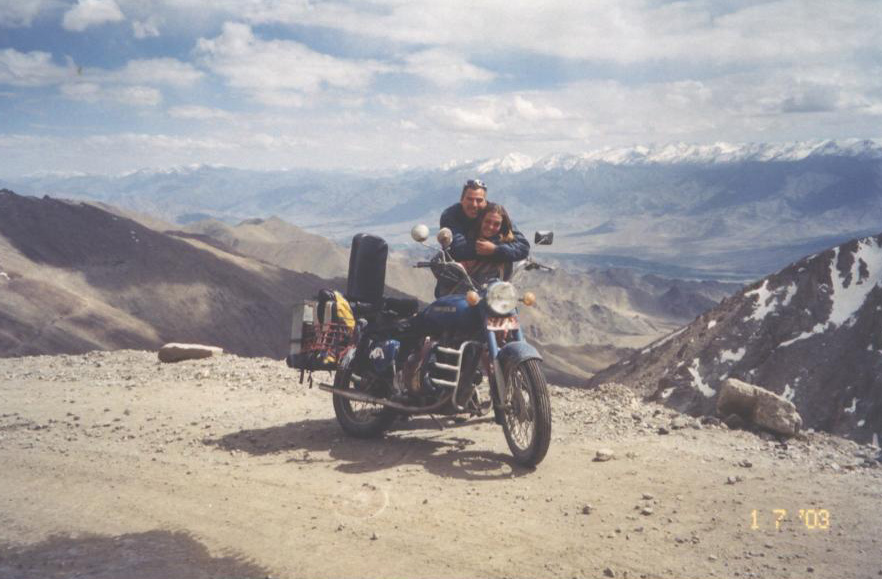We were excited of entering a new country, after 2.5 months in Colombia. Crossing with the bikes was hassle free, as opposed to our previous exit, buy bus.
There wasn’t much of a change, south Colombia seems more like a part of Ecuador than of Colombia: the people, the landscape, the prices, and even the bread in Ipiales!
One thing did change: $$$! It still amazes us that the economy of a ‘banana republic’ like Ecuador depends on the Dollar. We still converted Dollar to Peso and back to Dollar… we were used to prices in Colombia.

 Gals' new bicycle.
Gals' new bicycle.
 Sierra.
Sierra. Colonial house.
Colonial house.An Ecuadorian village
We reached San Gabriel in the late afternoon, just as it started raining heavily. We found a cozy guest house (with hot water) in an old colonial building, a 375ml bottle of Grants whiskey (for $7 – not bad!) and a nice colonial town. Sounds trivial, but not an easy task in Colombia, where towns are dangerous at night, alcohol is expensive and hot water is impossible to find. Bread finally tasted like bread.
 San Gabriel.
San Gabriel.




Otovalo 28/10/08
We arrived to famous Otovalo at night, after cycling in the dark for over an hour. It is good we are not in dangerous Colombia ;-)
We found a nice hotel with a balcony, had a hot shower, enjoyed our Grants and went to sleep. We woke up early and were surprised to see through our window a huge snow capped peaked volcano! Our first snow in Latin America! From the balcony we saw a second one looming over the city, also covered with fresh snow.
We enjoyed our morning coffee and attacked the main market. It was huge, and had everything! We haven’t been in real markets for so long, since Nicaragua. We bought lots of stuff and made pork with blackberry sauce. We ate the famous pies that Rami has been talking about for years.

 the views from the balcony.
the views from the balcony.
 through the binoculars.
through the binoculars. A good map.
A good map.The Oriente? 30/10/08
For a long time we have been thinking whether to cycle the congested Pan-Am, crossing Quito and through the “volcano Avenue”, or to cut east, down to the Amazon basin in the oriente, the jungle, and head south from there. We searched for info about the road situation over there, but no one knew much, only about the paved descent to Baeza.
We decided to give the oriente a chance. We hitched a truck from Otovalo to Pifo, on the road bypassing Quito from the east, to avoid the traffic. Gal was sick, so we found a hotel and rested. The family owning the place were very welcoming, a nice surprise.
The next morning we started climbing towards our first 4,000m pass in Latin America. Gal was feeling bad and we made slow progress. After climbing 1,000m we reached a restaurant, the last ‘something’ on the way up. We asked about camping and were invited to sleep in a comfortable hut, behind the restaurant, next to the river. The scenery was beautiful with a few llamas around, our first llamas/alpacas and tranquility. Who said Ecuadorians are not friendly and hospitable?
 On the way up.
On the way up. First llamas!!!
First llamas!!! Our cozy hut for the night.
Our cozy hut for the night.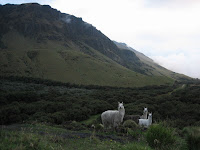 More llamas.
More llamas.
We got up at 04:00, hoping to reach the 4,065m pass before the clouds arrive. It was cold and dark outside, but pleasant in the hut (did we mention the bathroom, kitchen and the electricity?). We reached the pass quickly, despite the crazy Ecuadorian inclines (further south we will encounter more of these 10%-13% inclines); it was a bit disappointing, nothing special.
 Morning clouds.
Morning clouds. Our hosts.
Our hosts. The paramo.
The paramo. The pass.
The pass.

Down to the Amazonas 01/11/08
After the disappointing we had a 2,000m descent, an amazing (paved) downhill towards the Amazon. We passed 1,000,000 waterfalls in deep mountain jungle.
On the way we encountered a local TV reporter who interviewed us and filmed us cycling in this beautiful valley. He also gave us a pineapple (from his hometown).
We finally reached the peaceful settlement of Baeza. During the whole evening it rained like mad; very relaxing, sitting and watching.

 Another beautiful downhill.
Another beautiful downhill.




 Jungle!!!!
Jungle!!!! Millions of waterfalls.
Millions of waterfalls.



 Rain.
Rain.The next morning we optimistically hitched back 10km up the valley to a viewpoint of volcano Antisana. It was covered with clouds, again, after an hour it peaked here and there between the moving clouds.
 Waiting.
Waiting. Peeking.
Peeking.
The Oriente 02/11/08
We left Baeza, on the newly paved road, in beautiful tropical scenery, at 2,000m.
In the late afternoon we entered a national park (nothing better a road crossing a national park…). The perfect asphalt road changed to one of our worst dirt roads. The clouds arrived and we were surrounded with mist. A few minutes later the rain attacked. The road became a mud swamp with huge rocks. We could barely see the amazing scenery – a typical rain forest!
Darkness arrived and we barely road 6km (of downhill!), when we decided to hitch back, camp somewhere and enjoy the scenery tomorrow (we were told the national park continues for another 20km, with no water, houses or a place to camp, only the cliff). A pickup truck arrived and we piled everything, including Rami, behind (Gal inside) and ‘flew’ up the mountain, back to the last house we’ve passed. Rami was totally wet (well, the water proof clothes did work) but thrilled from how the 4x4 pickup attacked the road.
Rami asked the family for help, and we were invited to sleep/squeeze in their small house. The husband apologized for not mentioning earlier (when we talked, before entering the national park) that there is nothing for 25km.
We woke up early. It was still raining. We ate our small breakfast (we planned on arriving to a village yesterday) and waited… and waited… and waited.
At around 11:00, still pouring rain, we made our spare rice (+ spices and our last onion).
Finally, at 13:00, the rain stopped and we set off. It was still cloudy, but we have learned that rain forests are called “rain forest” because it usually rains there, and if it doesn’t rain it is cloudy. We had 18km of terrible unpaved road and amazing jungle scenery.
We reached a tiny town in the evening and were happy to be back in ‘civilization’. We ate a tasty choclo (barbecue corn) with cheese and garlic.




 The clouds attack.
The clouds attack. Thanks.
Thanks. Woke up, and it is still cloudy.
Woke up, and it is still cloudy.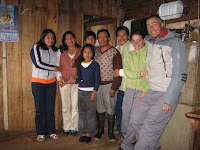
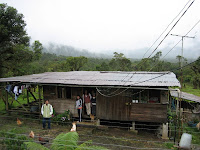 Our hosts and saviors.
Our hosts and saviors. Ramis' new look.
Ramis' new look. The rain forest.
The rain forest.





 Paved!!!
Paved!!! At least part of it...
At least part of it...


 Snake.
Snake. Crossing a bridge.
Crossing a bridge. One of a million butterflies.
One of a million butterflies. A view of the jungle.
A view of the jungle.

 Rainbow.
Rainbow. 2008 - the year of the asphalt!
2008 - the year of the asphalt!Good for us, better for next year cyclists.

 Next year...
Next year... Monkey!!!!!
Monkey!!!!! Should have taken him with us.
Should have taken him with us.Shuar 06/11/08
We had 2 days of dry jungle and agriculture, nothing special except for the heat. We even thought of hitching, but nothing passed for over half an hour, so we continued. Our map showed nothing on the way and the locals warned us of the indigenous Shuar reserve, nothing on the way. They were right. Ho, the road was badly unpaved again.
Towards sunset we passed a small community. Gal didn’t feel like camping in the middle of the village, so we continued.
The third house we asked invited us. They even offered a room. While cooking Chinese style vegetables, we saw a huge spider. This one was dangerous, they said, and stepped on it, crushing it, and 50 baby spiders ran out of it…
The family tasted our food and loved it (a lot), and brought us a few different types of bananas and sweet potatoes, cooked. We had a fantastic evening with interesting conversations. At the end of the evening, Miriam, the wife, gave Gal a gift: a beautiful handmade necklace. We gave them only dispensable thing we’ve been carrying for 2 years: a flag of Israel ;-)
We went to wash our hands and face in the only water supply they had – a small pool/swamp of rain water. During the dry season they have water problems (what dry season?). We were warned of the many snakes in the area. Gal had snake nightmares about tomorrows’ morning dump (there were no official toilets).
Later that night the father took a rifle and a flashlight and went down to the river to hunt. We were not invited to join, because during the dry season the leaves are dry and we’ll make noise. In the morning the father took us up the hill, to the local school, where Miriam worked. It was a magnificent viewpoint, overlooking the jungle and the winding river.
 In the kitchen.
In the kitchen. The viewpoint.
The viewpoint.The conference 07/11/08
The road to Macas was tiring and dry. We had no drinking water from last night with the Shuar. We reached the entrance to Macas just after sunset; only a broken bridge to cross!
Surprise – surprise, it started to rain and quickly built to a tropical storm. The huge hanging bridge collapsed not long ago and the river was high. A pickup truck helped us cross the bridge and took us into town. Totally wet we went to search for a hotel room. The first hotel we entered was full (and expensive). They told us it will be impossible to find a room now – there is a conference in town and a fiesta in a nearby village; the town is packed. Hearing we have camping gear they thought for a moment and invited us to open our tent inside the new wing of the hotel, still under construction. We had a huge room, an attached roof, toilets outside (on the roof, we improvised a door) and a faucet with only boiling water. What else does one need?

 Paved!!!!
Paved!!!!
 Newly paved!
Newly paved!We should bring some rivers to Israel...

 The collapsed bridge.
The collapsed bridge.We woke up before the sunrise, mad our morning black coffee (Turkish) and climbed to the roof, on the 7th floor. We saw the perfect cone of volcano Sangay.
Later we were invited for drinks by our ‘neighbors’, Colombians, working in construction in the hotel. They were not the first Colombian cheap labor we encountered in Ecuador. 10 years ago things were different.
For dinner we made pasta with cream sauce, with garlic & tomatoes (and beer) – a success.
To conclude, camping on our rest day is not the best, but it was a really nice gesture and a good solution.
 Magnificent volcano Sangay.
Magnificent volcano Sangay.



 Hiding from a storm.
Hiding from a storm. The owners of the hotel.
The owners of the hotel.Climbing to the Sierra – Park National Sangay 09/11/08
There was a lot of talk about the climb back to the sierra. After many inquiries, we decided to climb through Park National Sangay, to Guamote; very beautiful, but a very bad road, we were told.
The moment we left Macas we were on an unpaved road. Quickly the climb started.
2 hours later a tropical storm arrived. Luckily, there was a jungle hut nearby, so we hid there for half an hour. We were invited to chicken soup. Gal got the head of the chicken :-)
 The bad roads begin...
The bad roads begin...

 Now it's also muddy!
Now it's also muddy!
 Rami gets bitter and Gal enjoys the scenery...
Rami gets bitter and Gal enjoys the scenery...
In the late afternoon we saw through a hole in the clouds the beautiful volcano.
We reached a small village and were invited to sleep in a class in a school. Supplies for dinner were difficult to find.



 Many rivers to cross.
Many rivers to cross.
Cooking dinner at the school. Surrounded by 20 noisy and curious children. Not very relaxing...
The following day the road deteriorated even more and the inclines became steeper. We reached a bridge which has collapsed a week earlier, while 2 trucks tried crossing it simultaneously (one after the other, no one’s that stupid!).
Rami changed to flip-flops and pushed both bikes across the river. Gal hitched a truck.
Rami became even grumpier and demanded to hitch out of this terrible climb, claiming the scenery is not worth the damage to the body. A truck took us up, but at the first village Gal demanded to get off, seeing the incredible mountainous forest we were passing (one of the best scenery she saw…). We threw our luggage in a regional office of some sort and cycled down and then back up the part we just hitched. It became cloudy and the visibility was not as sharp. Gal was grumpy.
We opened our mattresses in that office. Supplies were even more difficult to find…


Oops, this is what happens when 2 heavy trucks try to cross together...
Easier with a bridge.
 Rami, pushing the bike.
Rami, pushing the bike.
 From the truck...
From the truck...
 Cycling back.
Cycling back.


 Ah, Beautiful.
Ah, Beautiful.






 Mushrooms, growing from cow shit.
Mushrooms, growing from cow shit.

 An animal.
An animal.

The next morning we cycled to a view point and waited over 2 hours for the clouds to move, hoping to see the volcano – nothing!
Rami still didn’t want to cycle this road, suffering more than enjoying so far. Gal was angry at Rami for not even willing to try. A pickup truck took us all the way up. Rami enjoyed the scenery from the back of the pickup, Gal was still heartbroken for not cycling this beautiful road.
 Brave Gal, entering a tunnel.
Brave Gal, entering a tunnel. In the tunnel.
In the tunnel.


 On the Pickup.
On the Pickup.We got off at the pass, where the road was paved again. We entered the paramo, with grasslands and lagoons, which quickly changed to the typical, boring sierra.
We slowly descended (not really descending) another day, camping in another school.
We left the paved road to a dirt road to Guamote.
Rami: very bad road.
Gal: every dirt road is a bad road for Rami.
In the quiet village of Guamote we slept in a nice hostel.

 The cloudy pass.
The cloudy pass.












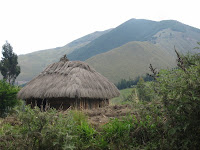
 Another night at a school, kids peeking.
Another night at a school, kids peeking. A funny donkey...
A funny donkey... Unpaved again.
Unpaved again. The Pan-Am!!!!
The Pan-Am!!!! Buying pork for dinner.
Buying pork for dinner.Market day 13/11/08
Thursday is market day in Guamote. Tens of thousands of locals from the surrounding campo arrive, selling everything from cattle to beans and even a flee-market. Everyone is wearing a hat – the typical hat!
We took the morning easy, planning on hitching To Quenca later, after the tough week we had.
We enjoyed trying to find our way through the crowd and talking many pictures.
Around 11:00 we left the village, stopped on the junction with the Pan-Am and waited. And waited, and waited…
All the trucks leaving the village were packed with ‘herds’ of people leaving the market. All you could see was millions of hats peeking out of the back of the truck. The problem was that they were all full or going to the nearby villages.
After 2.5 hours, desperate, we hitched a truck, to a nearby town, 30km away ;-(

 The market.
The market. The typical hat.
The typical hat.
 More hats...
More hats... How come no one wants to buy my sheep?
How come no one wants to buy my sheep?
 Hat corner.
Hat corner. Gulliver.
Gulliver. A huge nice dormitory to ourselves.
A huge nice dormitory to ourselves.We waited outside the town for another 1.5 hours, and nothing. There were still trucks filled with locals (with hats), but this time they were all leaving the bull-fight, part of the fiesta in town.
It was getting late & late, the afternoon sierra rain, so we cycled down to town, barely managed to find a hotel room (the fiesta) and went to see the bull-fight. After 1 minute of seeing the old skinny bull get stabbed, Gal had enough (not humane, they should ban it!), and we went to take a shower. The only comfort in this unsuccessful day was that we found out that there was hot water in our hotel room!
 The bull fight from above.
The bull fight from above. We don't want to carry a heavy glass bottle.
We don't want to carry a heavy glass bottle.Quenca 14/11/08
The next morning we caught a bus to Quenca, relying on our guide-book, which recommended the Quenca- Loja section as a highlight in Ecuador. We’re always sad to hitch (except for Rami :-), missing a part of the way; the scenery, sounds, smells and ambient are different from a small window of a bus. Parts were very beautiful (deep valleys), but, the sierra is still the same sierra!
5 hours later we arrived to the bus terminal of Quenca, quickly cycled to the center and found a cute, cheep hotel with a kitchen and cable TV in the room.
Quenca was exactly the place we needed, for recuperating, physically and mentally. The colonial center is not very impressing, but still has charm; the city is energetic and alive, with a nearby market and a modern nightlife with a rustic taste. We stayed there the whole weekend, enjoying the good atmosphere.
The 4 day journey to Loja was relaxed (not the cycling) and remote, with 1-2 climbs of 1,000m, everyday. On our first night, we were thrilled to be allowed to sleep in a tiny wooden shack, in a freezing 3,200m windy plateau. The next day we celebrated our 10,000km in Latin America, by changing Gals’ rear breaks, in a beautiful 1,300m descent to a hot, dry valley. That night we were invited to sleep in a room, in a cute finca.
 10,000km in Latin America!!!!
10,000km in Latin America!!!!
A nice valley.
 Chickens and cats.
Chickens and cats. Our room for the night.
Our room for the night.Juan Kishpe 19/11/08
We climbed to the village of Saraguro, where a unique, indigenous group lives. We enjoyed seeing the tasteful traditional outfits and the long black AAAAAA all the men had. We wasted an hour, checking the shitty, cheap hotels. We decided to continue; staying would be a waste of time and money. We had a long climb ahead.
It was getting dark and there were barely any places to sleep, nor any water for camping wild. A man on a horse told us of Juan Kishpe, the owner of the last house in the climb, a very hospitable man. We reached his tasteful adobe house, just before sunset. He was not in, but his wife, Gladice, took us in and invited us to sleep in a room on the second floor, a guest house still under construction. We enjoyed talking and cooking together.
A bit before dinner was ready, Juan arrived and we were introduced. We understood that there was a misunderstanding, Gladice thought we are friends of Juan (we truly didn’t try to give that impression), but very quickly it was all forgotten , as the conversation flowed, talking about our travels, the indigenous social/political situation in Ecuador and more. It was the first time we got to learn more thoroughly about the Inca culture. Juan Kishpe was an Inca descendant in region and culture.
The next morning, after waiting breakfast together, before leaving, they invited us to wear their elegant traditional clothes. Just before leaving, Rami bought a hat, lying in a corner, one of Juans’ old hats. The new and wise purchase, gave Rami a serious, sophisticated intelligent look. It’s true, we are against carrying souvenirs, useless weight, but the hat, like the old industrial lighter we found in Quenca (which we first saw at Mauricios’, in Colombia) was truly a wise purchase (sais Rami).
 Gladice and the kids.
Gladice and the kids. Juan, Gladice and Rami.
Juan, Gladice and Rami. Getting dressed.
Getting dressed. All dressed up.
All dressed up.
 We like the shirt...
We like the shirt...We hoped for an easy last day to Loja, but… after 2km of climbing Gal noticed we forgot the trailer flags! Rami took Gals’ bikes (easier to unload the luggage), zoomed down, got them ans was pulled up, catching the rear of a slow truck (thanks!).
The ups and downs continued, surprising us again, topping it all with a 10km unpaved climb, under construction.
We finally reached Loja, an uninspiring, sort of modern town. We had a few beers and enjoyed a bad dinner… the ease of not cooking.

 A nice valley.
A nice valley. Half paved is much better than not paved...
Half paved is much better than not paved...Before leaving, first thing in the morning, we went to one of the bus terminals to pick up a CD with our interview from 3 weeks ago, at the descent to the Oriente. We were thrilled to see that it arrived (mail services of bus companies are common in these countries) and checked it out in one of the DVD shops (“crazy tourists”, they thought).
On our first climb we were caught by rain, but the clouds quickly disappeared and we enjoyed the beautiful ride to Vilcabamba. We descended through a green jungle valley that changed to a dry and hot one, but with the heat came the yummy fried Platanos!

 Vilcabamba valley.
Vilcabamba valley.We entered the small (but growing) village of vilcabamba and parked on the square.
Olga (Spain) and Christian (Germany) approached us and introduced themselves as cyclists coming from the south. Since Cartagena, Colombia, where we met Mat and his partner (going south), we met only one cyclist (going north) in the middle of the road; not very comfortable. Olga & Christian were also adventurous cyclists, going as far as possible from the Pan-A, thus, seldom meting cyclists. We spent the evening together, exchanging info and subjective recommendations, sharing ironic stories, that only cycle tourists can truly relate to. They’ve been on the road for 3 years now, making us feel better – there are greater bicycle-bums than us!
We had a great night and are still in Email contact with them, hoping to meet again.
The next evening we made our famous (???) garlic soup (with the help of the kitchen of the guest house owners). Lacking butter, we used pork fat (!!!), giving it a unique taste! But, still, it was a success; the owners loved it!
 cooking on the roof top.
cooking on the roof top.Vilcabamba turned out to be a good place for a ‘rest day’. As usual, Rami was afraid of it being a ‘tourist-trap’, hearing so much about this touristy village already 12 years ago, but, except for a few hostels and foreigners living there, it is just a relaxed village in a beautiful valley. Maybe because we were there during the low season…
Just before leaving Vilcabamba, Manuel, the guest house owner, filled our gasoline supply (for our stove). There is no gas station south of Loja and prices in town are super high.
He gave us the usual speech about the young Israeli travelers, bad reputation and all, as apposed to us. It always makes us feel uncomfortable, having the need to apologize.
To the border 23/11/08
We headed south to the notorious La Balsa border. We knew the road will be terrible and the border might be problematic (the immigration officer is out, playing football... please wait), but very beautiful (and it was! Even more than beautiful).
We had a first short day - only 22km. Gal didn't feel well. We found a small room in a friendly house, in a tiny village. We spent the afternoon watching cockfights and local volleyball tournaments.

 Vilcabamba from above.
Vilcabamba from above.

 The cockfights.
The cockfights.On the next morning we entered the terrible unpaved road (till the border). Rami was extremely grumpy.
We were cycling next to Podocarpus national park. It was cloudy, rainy and cold, typical to a rain forest. A bit before a pass, we met Andy, a Swiss cyclist (we met his partner yesterday, near Vilcabamba). All of us were wet and cold. He seemed like after a war: one of his panniers were dangling, the other half open, his jacket torn, his lips blue and trembling from the cold. But, he was happy – happy to be away from the devastating heat in front of us!
We all knew it was not the time nor the place to chitchat, so after 10 minutes we departed, continuing the climb.


Just before the pass the clouds climbed. Grumpy Rami, was already at the pass and missed the views...


On the other side of the pass the weather was much better and we enjoyed magnificent scenery :-)
















We had 2 more incredible cycling days, with fantastic scenery and terrible roads, pushing the bikes a lot.
We met Gil and Omer, the first Israeli travelers we’ve met since Cartajena, Colombia (29/07/08). They were traveling on a motorcycle. later on, they emailed us recommendations of roads and cycling info (camping places, etc.).
On a steep decent, in the killing heat, one of Ramis’ break pads got loose and ‘ate’ the front Schwalbe tire. Let’s see how long will it survive!
 More rivers to cross...
More rivers to cross... And jungle...
And jungle...
 Millions of them out there, where Gal pees!
Millions of them out there, where Gal pees!
 More jungle!
More jungle!

 Wow!!!
Wow!!!




 More jungle!
More jungle! Omer.
Omer. Ramis' eaten tire ;-(
Ramis' eaten tire ;-(After experiencing the terrible road (dirt + slopes) and knowing the worst is still ahead of us, we decided to take a bus from Zumba to the border. We got up early and almost missed the morning bus. At 08:02 Rami caught the 08:00 bus (2 buses daily!) and we loaded our stuff for the 2 hour – 26km journey! Rami enjoyed the beautiful scenery from the roof of the bus/truck. And, yes, the road was bad.
 The views from Zumba, our balcony.
The views from Zumba, our balcony.

Formalities at the border were quick. Not notorious and not shoes, as the Hebrew expression says!

Goodbye 27/11/08
Ecuador is a cyclist heaven!
The landscape is very diverse (as long as you don’t stay n the Pan-Am) and extremely beautiful.
Many roads are being paved and traffic is sparse (we don’t know the coastal road).
While in Colombia, we were told that the Ecuadorians are not nice, warm and welcoming, but no one is as nice, warm and welcoming as the Colombians... but, we met a different Ecuador, in every part of the country we’ve been; the people are extremely warm and hospitable! They may keep their distance at first, but later everything changes.
We found the people more educated (even in the campo/countryside), raising the level of the conversation (from Maiz and Frijoles).
Another advantage: the country is SAFE! You can camp wild anywhere, walk at night in towns and villages and the general atmosphere is relaxed – as apposed to most Latin America countries, where the locals constantly warn you of “this road” or “that road”, etc.
Ecuador has its’ fair amount of tourists, but, cyclists are not affected by it; 5km away and you’re out of it. The locals are not greedy and don’t see tourists as ‘walking $$$’.
To conclude – a cyclists’ heaven.
But, be prepared for 13% slopes!!!
